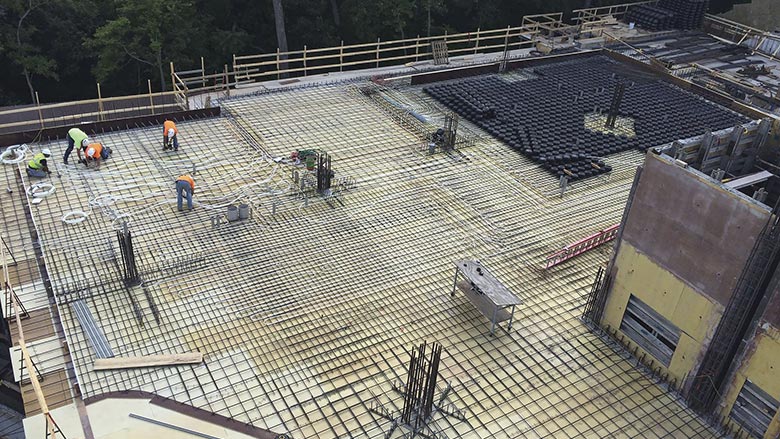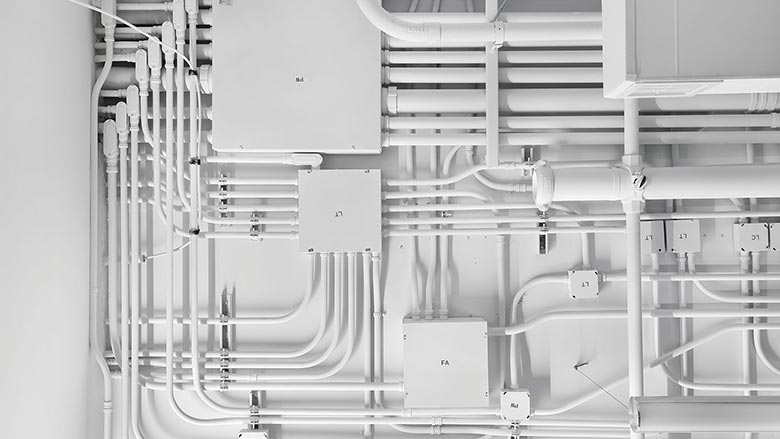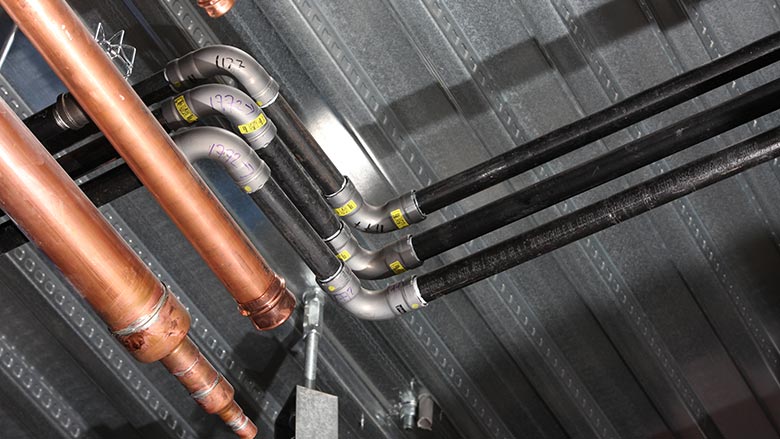All signs are pointing to a positive 2023 on the nonresidential construction front. On one hand, the sector is likely to be bolstered by funds from the Infrastructure Investment and Jobs Act (IIJA) and the CHIPS and Science Act of 2022. On the other hand, residential construction is anticipated to slow. Either way, it won’t be all smooth sailing ahead. Headwinds such as inflation and supply chain issues will continue to affect both residential and nonresidential segments, industry experts say.
“The residential market is going to cool down and stabilize while the multi-family housing, the commercial market and the industrial market are all looking healthy into 2023,” notes Christian Geisthoff, vice president of corporate development, Viega. “The architectural index is still showing stable conditions and everyone I talked to has bookings into next year, so those markets are likely to have the best prospects.”
Trey Northrup, Leader of LIXIL Americas, also thinks commercial is where the biggest growth prospects in 2023. “Commercial markets such as healthcare and education are growing at a faster rate than the residential markets, multi-family buildings and office buildings, which are expected to decline in year-over-year revenue in 2023.”
Greg Case chief product officer, global, Taco Comfort Solutions, agrees, saying there are upturns in higher education, hospital and health care, as well as multi-tenant construction.
“Considering the infrastructure bill, there's certain to be ongoing, strong growth in public water and sewer facility construction,” he says. “Of course, it’s not just new construction, but renovation and retrofit work to provide efficiency upgrades that will also keep contractors and engineers busy in 2023.
“The overall awareness of how energy efficiency and IAQ intersect — through healthy building initiatives — is resulting in smart, purposeful renovations across all segments of the commercial market. We’ve had a tremendous interest in our educational programs over the last year. For instance, as engineers are smartly pushing the efficiency more in their designs, things like understanding the pump system’s proper operating point using variable frequency drives to save energy has become a popular topic."

“Commercial markets such as healthcare and education are growing at a faster rate than the residential markets, multi-family buildings and office buildings, which are expected to decline in year-over-year revenue in 2023.”
— Trey NorthrupMark Chaffee, vice president of governmental affairs and commercial and industrial product management at Taco Comfort Solutions, adds that industry-wide labeling efforts have made an impact in that effort, too. “The Hydraulic Institute Energy Rating label on commercial and industrial pumps and circulators has made it quick and easy for stakeholders throughout the supply chain to see the benefits of choosing a more efficient product. Pump systems account for about 40% of industrial energy usage, but they don’t have to. Transitioning the market to ECM circulator pumps could save enough to provide a year’s worth of electricity for more than 1.5 million homes. With short paypack periods and a huge installed base, energy-efficient pump retrofits will also continue to be a strong market segment in 2023.”
Market disruptors to watch
One of the largest market disruptions next year will be preparing for the transition to A2L refrigerants as the phasedown of hydrofluorocarbons (or HFCs) for cooling applications continues, notes Lisa Reiheld, director, PMG technical resources for the International Code Council (ICC).
 Aerial shot of installation crews setting Wirsbo hePEX from Uponor on one of the six slabs in the thermally activated system. Courtesy of Uponor
Aerial shot of installation crews setting Wirsbo hePEX from Uponor on one of the six slabs in the thermally activated system. Courtesy of Uponor
“In terms of disruption to business, there is a potential for supply chain issues; getting the refrigerants and the corresponding equipment where they need to be could be a challenge,” she says. “There will be an additional need to properly train installers, distributors and building officials who conduct inspections. The Code Council will potentially be offering training in the future, but currently online training is available through both AHRI and ACCA.”
Dave Viola, CEO of The International Association of Plumbing & Mechanical Officials (IAPMO) points to the ongoing war in Ukraine as the biggest potential market disruptor in 2023.
“The war in Ukraine will continue to create havoc in energy markets, drive inflation and increase market uncertainty,” he says. “On the technology side, we see a continued trend of plumbing digitalization and sophistication as we continue to grapple with plumbing resiliency issues such as water conservation, safety and access. The wild card will be COVID-19. Hopefully, we will not have to deal with any virulent variants that could slow our recovery.”

“Considering the infrastructure bill, there's certain to be ongoing, strong growth in public water and sewer facility construction. Of course, it’s not just new construction, but renovation and retrofit work to provide efficiency upgrades that will also keep contractors and engineers busy in 2023.”
— Greg CaseChaffee adds the steadily rising rates of energy — in all forms, from electricity to natural gas, LP gas and oil — is something to keep an eye on next year.
“This is forcing lifestyle changes, and that’s placing greater importance on equipment and components that save energy — from higher efficiency systems to components like ECM circulators,” he says. “Most people in their adult lives really have not seen inflation, now they're dealing with it substantively.
“A bright spot is that the solar energy market is maintaining its steady growing,” Chaffee adds. “But it’s the combination of all of these that truly becomes the tsunami we’re talking about. Gone are the days of carefree and inexpensive energy use, or lack of concern for homes and buildings that aren’t properly insulated. Just as incandescent lights were flushed out — almost gone overnight in favor of LEDs, our old, lazy habits are being re-shaped. We’re seeing the acceleration of a political and regulatory environment that has no toleration of wasteful energy use. The use of fossil fuels are under scrutiny like never before, and being pushed out as forcefully as possible. Net zero policies and carbon reduction are the key movers here.”
2023 challenges
One of the biggest challenges the industry will face next year is not new. The skilled trades have been suffering from a labor shortage for years, and it won’t be magically solved in 2023, unfortunately.
“With the trade talent shortage remaining tight and inflation continuing to surge, industry professionals will need to be diligent with their workforce to keep individuals motivated while also ensuring they are on the cutting-edge of technology to keep both customers and employees satisfied and engaged,” notes Brett Boyum, vice president of marketing and offerings for Uponor North America. “Discovering and offering new technologies, such as the new AquaPort from Uponor, will help industry professionals stay relevant with customers and add efficiencies to projects.”
“There are twice as many plumbing and HVAC jobs out there as there are people to fill them,” Reiheld says. “A lot of organizations, including PHCC and SkillsUSA, are pushing to fill the talent pipeline by providing training and apprenticeships — young professionals should look for those opportunities. We should all be reaching out to high school students and young people who are trying to ‘figure out what they want to be when they grow up,’ to open their eyes to these careers. I encourage anyone who is early in their career and still making decisions to look into mentorship, professional development, training and networking opportunities for building safety professionals through the Code Council’s Safety 2.0 program.”

“In terms of disruption to business, there is a potential for supply chain issues; getting the refrigerants and the corresponding equipment where they need to be could be a challenge.”
— Lisa ReiheldGeisthoff also points to the labor shortage as the greatest challenge heading into next year.
“The other challenge is the integrated production process in our industry in general. Efficiency gains in our industry are a lot smaller than in other industries. Combine that with the labor challenge, and it makes completing projects on time more difficult. Raw material pricing inflation is going to be a challenge into 2023 because inflation is going to continue to squeeze the margins on people who have already signed contracts for their pipeline.”
According to Viola, inflation will remain difficult to control, at least through the first half of 2023, which will impact lending and all areas of construction.
 Because so much of the piping and conduit would not be hidden behind walls or in ceilings for this project, thousands of feet of pipe had to be meticulously coordinated, so that systems were arranged in fastidiously neat and precisely parallel runs. The piping and conduit were painted a uniform white to make them less noticeable. Courtesy of Uponor
Because so much of the piping and conduit would not be hidden behind walls or in ceilings for this project, thousands of feet of pipe had to be meticulously coordinated, so that systems were arranged in fastidiously neat and precisely parallel runs. The piping and conduit were painted a uniform white to make them less noticeable. Courtesy of Uponor
“In addition to increasing material costs, interest rates are climbing at a very fast pace, the impacts of which will not be known for months,” he explains. “Every aspect of construction will feel a pinch as lending and economic activity slows down. Optimistically, we hope to see some stabilization in the second half of 2023. We’re also hopeful that we’ll have a soft landing for the economy and that a resulting recession will not be severe as economies stabilize. That said, as the pandemic showed us, plumbing is essential. Safe drinking water and sanitation are always IAPMO’s primary considerations. The plumbing and mechanical industry proved to be to be more resilient than other industry sectors in the 2008 recession. We believe that will be the case next year, too.”
Reiheld agrees that the industry will not see prices coming down anytime soon because there are still materials shortages. “I do think you’ll start to see some relief in terms of material costs in 2024 as the economy continues to improve and we get further away from the supply chain issues caused by the pandemic. When fuel prices come down, materials prices will likely follow.
“In the meantime, I think it would be wise to shop around and expand your network of suppliers,” she continues. “Smaller businesses should consider partnering with similar-sized organizations to pool their resources and purchase larger quantities to get the best possible prices on raw materials.”

“Just as incandescent lights were flushed out — almost gone overnight in favor of LEDs, our old, lazy habits are being re-shaped. We’re seeing the acceleration of a political and regulatory environment that has no toleration of wasteful energy use. The use of fossil fuels are under scrutiny like never before, and being pushed out as forcefully as possible. Net zero policies and carbon reduction are the key movers here.”
— Mark ChaffeeThe recession is expected to negatively impact manufacturers’ pricing power as consumers pull back on spending, Northrup adds.
“In many instances, we will see manufacturers reducing prices in order to offload excess inventory,” he says. “Simultaneously, rising inflation levels are expected to cause many consumers to defer project start dates until 2024–2025, especially projects in the $7,000-$35,000 price range — though these projects are still expected to occur in 2025 and beyond.”
Boyum also anticipates rising material costs and inflation to continue to be a factor in 2023. “The best way to minimize this impact will be incorporating efficiency solutions, such as design services, BIM resources, kitting options and prefabrication capabilities to keep projects as streamlined as possible. In fact, Uponor has begun offering all these services and solutions to help customers ensure order optimization, reduce job-site waste, and deliver greater installation efficiencies.”
Another challenge going into next year are the increasing state and local natural gas bans.
Most recently, the California Air Resources Board (CARB) unanimously voted to approve a proposal that would eliminate the sale of gas-powered furnaces and water heating appliances by 2030. This growing trend will have broad implications across the plumbing and heating industry.
 The residential market is going to cool down and stabilize while the multi-family housing, the commercial market and the industrial market are all looking healthy into 2023, according to Viega's Christian Geisthoff. Courtesy of Viega
The residential market is going to cool down and stabilize while the multi-family housing, the commercial market and the industrial market are all looking healthy into 2023, according to Viega's Christian Geisthoff. Courtesy of Viega
“There will be some impact on natural gas, but I think the decline is going to be slow, over the next five to six years,” Geisthoff says. “There are certain states that explicitly allow the use of natural gas, and for the residential and commercial side, I think it will stay for a while. The impact to the plumbing and HVAC market is going to be how we start to innovate a little bit more. Companies like ours can innovate to make sure that we have the right products available, and those that do will be the ones to lead in those areas later on. Regardless of the medium, we still need to run pipes to heat the building and carry water throughout the structure. You still need sprinkler systems and drain lines. It’s important that we have the products that contractors need.”
Viola notes the natural gas bans will increase the focus on the development of super-efficient heat pumps.
“Research is currently underway to determine if Hydrogen fuel can be utilized as a more environmentally-friendly option for heating, especially for the existing building stock that uses natural gas,” he explains. “Additionally, IAPMO is working with industry to identify other potential standards and certifications that simultaneously help promote health and safety while reducing energy usage. As we work to become more energy efficient, it will be important that we avoid unintended consequences that compromise health and safety. This kind of holistic thinking will be needed moving forward.”
Viola says IAPMO’s Hydronics Standards Committee is continuing to work on creating an American National Standard and Canadian National Standard for the performance requirements of geothermal energy network, also known as district systems. “District systems are slowly getting recognition in the industry as an additional source of energy and/or sink for a more efficient system.”
While the number of areas with natural gas bans is slowly growing, the plumbing and fuel gas professionals on the frontlines are not yet being impacted. The idea, in fact, probably seems abstract to them, Reiheld notes.

“That said, as the pandemic showed us, plumbing is essential. Safe drinking water and sanitation are always IAPMO’s primary considerations. The plumbing and mechanical industry proved to be to be more resilient than other industry sectors in the 2008 recession. We believe that will be the case next year, too.”
— Dave Viola“They’re not yet seeing the implications play out,” she says. “That said, I think it’s important for them to become more familiar with how these bans will impact their area(s) in the short and long term. One resource I can recommend is the U.S. Department of Energy’s Alternative Fuels Data Center which can be found here. I’m also concerned about where bans have occurred, what other energy sources will take the place of natural gas besides electricity. Especially considering that the power grid is already taxed under current demands in several locations, we’ll have to be careful and devise strategies that won’t tax the grid beyond what we’ve already seen in places like California.”
Keep an eye on these technologies
The new year will also bring new products and innovations to provide solutions in this rapidly changing industry. Artificial Intelligence (AI) and automation are two things Geisthoff expects to see more of in 2023.
“We’re seeing AI being used to create better building designs,” he says. “Automation of the installation process can provide better control tools over the production side and how we manage between the different trades. Both AI and automation are working in applications that manage water resources, so I think that is something that will continue.”
Case notes 2023 will be all about connectivity.
“Connected homes and integrating vast amounts of communicating commercial technologies holds lots of opportunities in 2023 and beyond,” he explains. “Things are getting smarter and more connected every day. Using all this data to make more intelligent decisions, to save fuel, to increase the IAQ of buildings is the next great challenge.
“Just look at the commercial office market, where facility managers and building owners are now facing shifting occupancy issues,” Case continues. “Many folks are be returning to work in facilities built for much larger numbers of people, now occupied with 40% to 60% of the numbers that they once held, and that too can vary widely by the day of the week. These new occupancy levels challenge many facets of building operations, including ventilation, cooling and heating — and how systems can be used in ways that use energy mindfully. Gladly, though for managers of hydronically-heated or cooled facilities, those buildings provide the greatest resilience and flexibility. Putting performance data together with these new operational realities and then combining it with unique and flexible hydronic based HVAC designs will help create extraordinary value for building owners.”
According to Reiheld, solutions for water conservation and reuse will continue to drive innovation in 2023.

“We’re seeing AI being used to create better building designs. Automation of the installation process can provide better control tools over the production side and how we manage between the different trades. Both AI and automation are working in applications that manage water resources, so I think that is something that will continue.”
— Christian Geisthoff“On the consumer side, look for the common use of phone applications that push notifications to homeowners or renters about water leakage in their homes,” she says. “This technology will become more mainstream in the years to come, but we’re already seeing it in early use right now. These solutions will help conserve water and prevent property damage from leaks. Currently, the 2021 International Plumbing Code (IPC) permits the use of leak detection devices when approved by the code official. With the recent publication of an ANSI standard for such devices, expect to see additional guidance provided in the 2027 version of the IPC.
“On the municipal side, water leakage is a harder problem to solve,” Reiheld adds. “Municipalities will need to invest federal funds that are available to replace aging infrastructure with modern materials and methods of installation.”
Viola agrees, saying that technologies pertaining to the water energy nexus, especially those impacting safety, will likely see the greatest growth potential in 2023. “The water shortages we are seeing in the western U.S. are not going away. Water quality concerns — primarily in the realm of Legionella, PFAS and lead — are also not going away. Technologies that can address both simultaneously have the greatest opportunity for market growth in 2023.”
Hopeful for a new year
IAPMO has a busy year ahead as it works to bring the Water Demand Calculator into the non-residential construction market; works to continue the 2023 edition of WE-Stand; and continues to collaborate with NIST and industry partners to address the most important research needs for plumbing systems.
“On the policy side, we’ll continue to work hard to help inform elected leaders at all levels of government on the needs of the plumbing and mechanical industry and will work to help develop new legislation and regulations to improve water safety and security, and that helps to keep our vital industry strong,” Viola says. “IWSH will also have a busy year. With COVID-19 restrictions generally being lifted across the globe, IWSH will be better able to plan for in-person projects both here in the U.S. and internationally.

“The best way to minimize this impact (inflation) will be incorporating efficiency solutions, such as design services, BIM resources, kitting options and prefabrication capabilities to keep projects as streamlined as possible. In fact, Uponor has begun offering all these services and solutions to help customers ensure order optimization, reduce job-site waste, and deliver greater installation efficiencies.”
— Brett Boyum“Despite the headwinds mentioned above, we’re hopeful that 2023 will be the year that economies finally shake off the remnant impacts of the COVID 19 pandemic,” Viola adds. “We hope to see supply chain problems continue to stabilize, and hopefully made more robust. We’re also hopeful that employment demand stabilizes and that our efforts to address our industry manpower needs continue to pay dividends. This will help business better understand their markets and invest with confidence in a growing economy. Will this all happen in 2023? It would be great if we had a crystal ball to know for sure, but IAPMO is approaching 2023 with a great deal of confidence and with an intention to invest in our future.”
Reiheld notes that ICC is excited to release the 2024 I-Codes next year, and that the code body is also in the process of establishing the Plumbing, Mechanical, and Gas Code Action Committee (PMG CAC) for the next cycle of code development for the 2027 Code editions.
“2023 will be a busy year for the ICC-PMG team as we partner with our colleagues in technical services and publications to finalize the International Comprehensive Plumbing Code (which will contain plumbing and fuel gas requirements for all occupancies including accessibility requirements),” she says. “We’ll also be developing state-specific PMG training content for several more states.”
ICC is also in the process of laying groundwork and conducting research for two new plumbing standards: ICC 815, Standard for Sizing Water Distribution, Sanitary Drainage and Vent Piping Systems and ICC 825, Private Sewage Disposal Systems.
“The committees will be coming together in Q1 of 2023 to begin work on these standards,” Reiheld says. “Time is of the essence for these standards — our aging plumbing infrastructure in this country is based on 1940s design and construction practices when we had three bedrooms and one bathroom in most houses. Today’s homes have at least two or three bathrooms, and we need to modernize our infrastructure and pipe sizing to efficiently use both water and energy. With water shortages being a global problem, I think 2023 is a great time for everyone to make a New Year’s resolution to conserve water. It’s our most valuable resource and we must protect it.”
Geisthoff is also hopeful for next year.
“Everyone is talking about a recession, but everyone I’ve talked to is optimistic for next year,” he says. “Their books are full. Their financing has already been secured. There is going to be some volatility ahead, but the overall picture going into the next year and beyond is a positive one, if you look at it holistically. It is going to be dependent on how we respond to some of the continued issues that we’re seeing, whether that’s inflation or margin crunch or labor shortages.”



